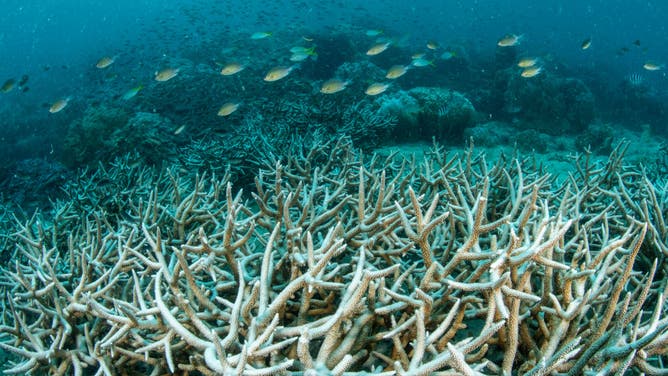World
World in midst of greatest coral bleaching event in history

An ongoing coral bleaching event is likely the most expansive the modern world has ever seen, according to data from NOAA.
Since 2023, more than 70% of the world’s reefs have experienced a level of heat stress, surpassing events recorded in 1998, 2010 and 2014-2017.
According to NOAA, mass bleaching of coral reefs has been confirmed around Florida, the Caribbean, Brazil, the eastern Pacific Ocean, Australia, the South Pacific, the Indian Ocean, the Red Sea, the Persian Gulf and the Gulf of Aden.
Bleaching occurs when elevated water temperatures cause stress to the corals, leading to the expulsion of microscopic algae.
As a result, the corals tend to lose their vibrant colors; however, NOAA cautions that discoloration does not necessarily mean the invertebrates are dead.

Coral Reef Watch Map
(NOAA)
ANTARCTICA’S ‘DOOMSDAY GLACIER’ IS MELTING AWAY DIFFERENTLY THAN SCIENTISTS FIRST THOUGHT
The previous record event from 2014 to 2017 saw 65.7% of the world’s coral reefs experience bleaching-level heat stress, making it the most widespread occurrence recorded to date.
NOAA says in addition to change-induced temperatures, significant runoff, pollutants and varying tide levels can also impact the health of corals.
Healthy corals play a vital role in marine ecosystems by providing shelter for essential algae across the oceans.
According to biologists, herbivores, such as small fish, feed directly on algae, leading to a much larger food web.
“As the world’s oceans continue to warm, coral bleaching is becoming more frequent and severe,” Derek Manzello, a coordinator at NOAA’s Coral Reef Watch, previously stated. “When these events are sufficiently severe or prolonged, they can cause coral mortality, which hurts the people who depend on the coral reefs for their livelihoods.”

TRAT, THAILAND – MAY 07: A field of bleached Staghorn coral (Acropora sp.) is seen in a shallow reef with a large school of fish on May 07, 2024 in Trat, Thailand. Extreme heat has driven Thai sea temperatures to record highs, causing severe damage to marine ecosystems. Coral bleaching and seagrass bed degradation are threatening the ecological balance and the livelihoods of coastal communities that rely on these marine resources. Similar marine events are playing out across a vast swathe of Asia, from the Great Barrier Reef in Australia to the delicate coral ecosystems of Indonesia and Thailand.
(Photo by Sirachai Arunrugstichai/Getty Images / Getty Images)
‘UNCOVERING A PIECE OF HISTORY’: EXPLORERS FIND CAMERAS ON GLACIER LEFT BY YUKON HIKER IN 1937
NOAA estimates that more than 1 billion people worldwide benefit from the ecosystem that coral reefs provide.
Warm waters are not believed to be the sole cause of bleaching events, as ocean temperatures that are significantly below normal are also known to cause issues.
In 2010, a significant deviation from average temperatures around the Florida Keys was reported to have caused substantial coral mortality.
A sudden shift from the 2009–2010 El Niño to the 2010 La Niña contributed to water temperatures dropping more than 10 degrees below average during the winter months, causing significant cold stress to the corals.
“Climate model predictions for coral reefs have been suggesting for years that bleaching impacts would increase in frequency and magnitude as the ocean warms,” Jennifer Koss, director of NOAA’s Coral Reef Conservation Program, stated.










